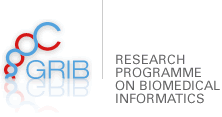
14/06/2013
Thesis defence of Eneritz Agirre: "Epigenetics in alternative splicing: links between chromatin structure, transcription and non-coding RNA mediated regulation"
On June, 21st at 11:30 at the Xipre room of the PRBB, Eneritz Agirre, member of the Regulatory Genomics group of GRIB (IMIM-UPF) will defend her thesis. You are all invited to this event.
Abstract
The regulation of alternative splicing has been generally thought of being primarily controlled by the interaction of splicing factors with the RNA molecule and by the elongation rate of the RNA polymerase II (RNAPII). There is an emerging understanding of the complexity of how alternative splicing is regulated which now involves the activity of non-coding RNAs and the chromatin state. Different experiments have shown that histone modifications can regulate the inclusion of alternative exons and that the elongation rate of the RNAPII could be influenced by different chromatin states. In this sense, small RNAs (sRNAs), which are a family of non-coding RNAs associated with members of the Argonaute family of proteins, that are effectors of the silencing pathway, which can participate in an alternative pathway known as transcriptional gene silencing (TGS). Experimental evidence shows that siRNAs targeting introns can induce chromatin marks that affect the rate of transcriptional elongation, affecting the splicing of pre-mRNAs, which is called transcriptional gene silencing alternative splicing (TGS-AS) (Allo et al. 2009). Thus, we proposed that the Argonaute protein (AGO1) could trigger heterochromatin formation and affect splicing by affecting RNAPII elongation.
In order to perform a genome-wide analysis of the regulation of alternative splicing we used new high-throughput sequencing technologies as ChIP-Seq and RNA-Seq. We found that there is AGO1 dependent alternative splicing regulation, and our results suggest that endogenous sRNAs could be involved. Additionally, in the last part of the thesis we show a cell specific alternative splicing chromatin code, which also involves AGO1. Even though AGO1 regulation of alternative splicing was related to some specific cases, we found that other effectors, CTCF and HP1 alpha were also important for the splicing changes decisions. This thesis and other recent reports show the regulation of alternative splicing as an integrated process, which involves many nuclear components and probably more that still need to be uncovered.



